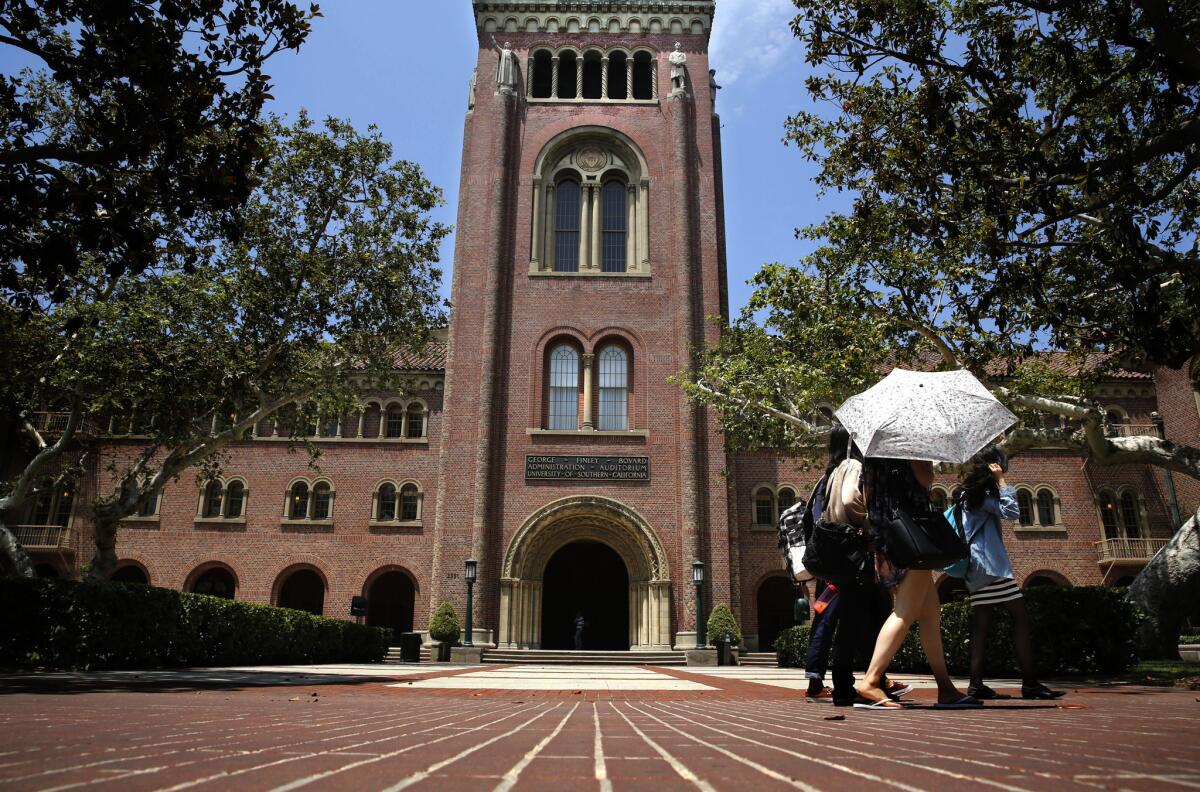Drug overdoses probed in USC student deaths, pointing to ‘twin epidemics’

Some of the nine recent deaths of USC students are potentially linked to drug overdoses, reflecting a growing concern among educators and health officials about rising drug use by college-age adults and the need for greater mental health services at universities.
Particularly worrisome is that investigators are probing whether any of the USC deaths are connected to tainted drugs — drugs touted as one thing but which actually contain more potent narcotics.
“We all know that people that get drugs on the street have no idea what is in those drugs,” USC President Carol Folt said Wednesday.
Three of the USC deaths were by suicide, according to campus officials. Although Folt would not elaborate on the circumstances of the individual deaths, citing federal student privacy laws, she said USC is working with the Los Angeles Police Department on the other cases and “doubling down” on education and outreach over drug abuse.
No links to contaminated drugs have yet been confirmed, according to sources who spoke to The Times on the condition on anonymity because they were not authorized to comment. Autopsies and toxicology tests are still pending in a number of the deaths.
But in what experts say is the latest wave of the opioid epidemic, the potent narcotic fentanyl has been increasingly showing up in non-opioids like cocaine and ecstasy, the kinds of substances that students may experiment with on a college campus. The addition of fentanyl, a white powder that can be lethal even in very small amounts, makes other drugs drastically more deadly, experts say.
In a letter sent to students just after 10 p.m. Tuesday, top USC officials warned against the dangers of opioid use and the mixture of drugs with other substances. Officials decided to relay new information and the risks of narcotics to ensure student safety, said USC Police Chief John Thomas.
“You [students] may feel invincible, but you are not,” Thomas said. “Please look out for yourself and your fellow students.”
School officials said that on its campus of roughly 47,500 students, USC has four to 15 student deaths in a typical school year. While nine deaths is not abnormal, the number in such a short time has been especially jarring for the community.
“The deaths are very alarming,” said Dr. Caleb Alexander, co-director of the Johns Hopkins Center for Drug Safety and Effectiveness. “There’s no corner of the U.S. that’s been spared from the opioid epidemic, and college students are clearly vulnerable.”
Between 2006 and 2016, the rate of drug overdose deaths nationwide among people ages 15 to 24 jumped more than 50%, though it still remains lower than that of most other age groups, according to federal data. But the rise in fentanyl could hit youth particularly hard, experts say; college-aged people in California are already more likely to die from overdoses of fentanyl and heroin than older drug users, who more commonly overdose on prescription opioids.
Sarah Van Orman, USC chief health officer for student health, said Wednesday that the university has not seen a rise in opioid use, but for many years a small percentage of students have reported using the drug. She said the risk posed by synthetic fentanyl is emerging on campuses throughout the country.
Risk factors for suicide and drug overdoses can be similar, with both often driven by an ambivalence about life, said Dr. Paul Nestadt, a Johns Hopkins University psychiatry professor. And rates of suicides and overdoses have been increasing among young people in recent years, he said.
“They’re both kind of going up at the same time, almost twin epidemics,” he said.
Folt said Wednesday that she had reached out to other universities that have experienced multiple student deaths for potential lessons about how to handle such tragedies amid what she called “a serious epidemic of mental health and wellness problems” nationwide.
The 2018 National College Health Assessment reported that two-thirds of college students surveyed felt overwhelming anxiety, loneliness and sadness. About 42% felt so depressed that it was difficult to function and 12% seriously considered suicide.
Folt said that loneliness could be exacerbated by “an artificial sense of connection” on social media. Stress is rising, she said, and drug abuse is worsening with the use of prescription drugs and opioids.
“That is not what it was when I started in universities many years ago,” she said.
The spread of fentanyl has been a particular concern among public health experts in recent years. Fifty times stronger than heroin, fentanyl was developed as a prescription painkiller and is often given to cancer patients in the form of a skin patch. But it’s the illicit version, a powder that can be mixed into other drugs, that worries health officials.
In 2016, 28 people in Sacramento overdosed on counterfeit Norco laced with fentanyl and several died. Last year, three men in Los Angeles died after snorting cocaine that contained fentanyl.
California has been somewhat spared from the worst of the opioid epidemic, in part because its drug market is dominated by stimulants such as methamphetamine, experts say. But that could change if those very drugs start containing fentanyl as well, they say.
“The presence of fentanyl in cocaine and other non-opoid drugs represents an extremely difficult and serious problem for public health authorities and for drug users alike,” Alexander said.
USC officials warned specifically about the dangers of mixing opioids and alcohol, saying that together they can be fatal.
Indeed, both substances, which are sedatives, slow the body’s central nervous system, sometimes halting breathing, Alexander said. It’s not uncommon to find alcohol in the bloodstream of someone who died of an opioid overdose, he added.
“Opioids are easy to overdose on, and alcohol makes that easier still,” he said.
USC officials are encouraging students to seek mental health treatment.
Folt said USC has increased the number of mental health professionals by nearly 50% since she arrived on campus in July. In addition, a webpage, “Trojans Care for Trojans,” offers resources and contacts for those in need of help.
Both the University of California and Cal State University have also reported greater demand for mental health services, including a 78% increase at UC campuses in the last decade — nearly three times higher than enrollment growth during that same period. The systems have also increased mental health resources, either by adding more counselors or peer mentoring.
Folt added that USC will be “reevaluating” campus communication policies as it seeks first to attend to those closest to students who have died or are in crisis while also informing the broader public.
“But now’s not the time for that kind of policy,” she said. “Now is the time for caring for people.”
More to Read
Start your day right
Sign up for Essential California for news, features and recommendations from the L.A. Times and beyond in your inbox six days a week.
You may occasionally receive promotional content from the Los Angeles Times.










